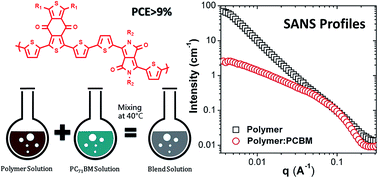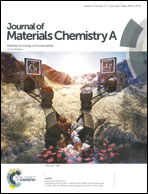Low band-gap conjugated polymer based on diketopyrrolopyrrole units and its application in organic photovoltaic cells†
Abstract
A new conjugated polymer utilizing diketopyrrolopyrrole (DPP) and benzo[1,2-c:4,5-c′]dithiophene-4,8-dione (BDD) units as the backbone framework was designed, synthesized, and applied in polymer solar cells. A high efficiency of 9.18% was obtained using phenyl-C71-butyric acid methyl ester (PC71BM) as acceptor, which was among the best results obtained for DPP-based photovoltaic polymers. Absorption spectra indicated that the new polymer exhibits a narrow optical band-gap and strong aggregation behavior in the solution state. It was found that by dissolving the donor and acceptor in different solvents and then mixing them before film casting, better performing solar cell devices and distinct film morphology could be achieved, rather than by dissolution in one solvent. Small-angle neutron scattering (SANS) profiles showed that PC71BM in solution impaired polymer aggregate formation, because of its favorable interaction with the polymer chain. This study demonstrated the importance of manipulating the aggregation state in bulk heterojunction solar cell fabrication and revealed the influence of polymer-fullerene interplay on the blend film morphology.



 Please wait while we load your content...
Please wait while we load your content...